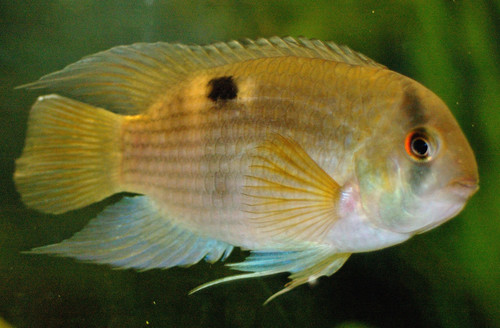
Keyhole Cichlid
The Atlantic bluefin tuna (Thunnus thynnus) is a highly migratory, large pelagic fish found in the Atlantic Ocean. Renowned for its size, speed, and commercial value, this species plays a critical role in the marine ecosystem. This article provides a comprehensive overview of this magnificent and increasingly threatened fish.
8 10 years
Lifespan
10 cm
Length
Least Concern
Conservation Status
N/A km/h
Swimming speed
Omnivorous
Diet
Sedentary
Migration
Appearance Overview
The Atlantic bluefin tuna is renowned for its large, streamlined body, built for speed and endurance in the water.
Coloration
Metallic dark blue above and shimmering silvery-white below
Body Shape
Torpedo-shaped body
Fins
Two dorsal fins, the first depressible; small finlets running from the dorsal and anal fins to the tail
Scales
Small and cycloid (smooth-edged)
Length
Up to 13 feet (4 meters)
Weight
Up to 2,000 lbs (907 kg)
Diet
Carnivorous, feeding on a variety of fish, squid, crustaceans, and eels.
Feeding Behavior
Opportunistic predators, they use their speed and agility to hunt. They are also known to cooperate in groups to herd and capture prey.
Social Behavior
Highly migratory, forming large schools, especially during spawning season. They exhibit complex social behaviors.
Commercial Relevance
Extremely high value, particularly in the sushi and sashimi markets in Japan. Its meat is considered a delicacy.
Conservation measures
Subject to international fishing quotas, fishing gear restrictions, and monitoring programs. Efforts also include tagging and tracking to study migration patterns.
Status
Endangered
Threats
Overfishing is the primary threat. Other threats include bycatch in fishing gear and habitat degradation.
Habitat Distribution
Depth Range
0-1,000 meters (0-3,280 feet), though they typically spend time in the upper layers of the ocean.
Geographic Range
Widely distributed across the North Atlantic Ocean, from the Gulf of Mexico to Newfoundland and from the Canary Islands to the Norwegian Sea.
Preferred Environment
Pelagic, preferring temperate and subtropical waters. They are highly migratory.
Reproduction and Life Cycle
Breeding Habits
Spawns in two known areas: the Mediterranean Sea and the Gulf of Mexico. Spawning typically occurs in spring and summer.
Development Stages
Eggs are pelagic and hatch into larvae. The larvae are fast-growing, undergoing several developmental stages before reaching adulthood.
Fecundity
Highly fecund; a single female can produce up to 30 million eggs per spawning season.
Maturity Age
Reaches sexual maturity at around 4-8 years of age, depending on the population.
Faqs about Keyhole Cichlid
How long do Atlantic bluefin tuna live?
They can live up to 40 years, although this is becoming less common due to fishing pressure.
How fast can Atlantic bluefin tuna swim?
They are among the fastest fish in the ocean, capable of bursts of speed up to 43 mph (70 km/h).
Are Atlantic bluefin tuna warm-blooded?
Yes, they are warm-blooded, which allows them to maintain a higher body temperature than the surrounding water, aiding in muscle efficiency.
How far do Atlantic bluefin tuna migrate?
They travel vast distances across the Atlantic Ocean, with some populations making transatlantic migrations.
Where do Atlantic bluefin tuna spawn?
The two main spawning grounds are the Mediterranean Sea and the Gulf of Mexico.
Why is Bluefin tuna meat so expensive?
Bluefin tuna meat is prized for its flavor, texture, and high fat content, making it ideal for sushi and sashimi.
Copyright @ Nature Style Limited. All Rights Reserved.
 English
English